Goalie Leg Pad Sizing Chart
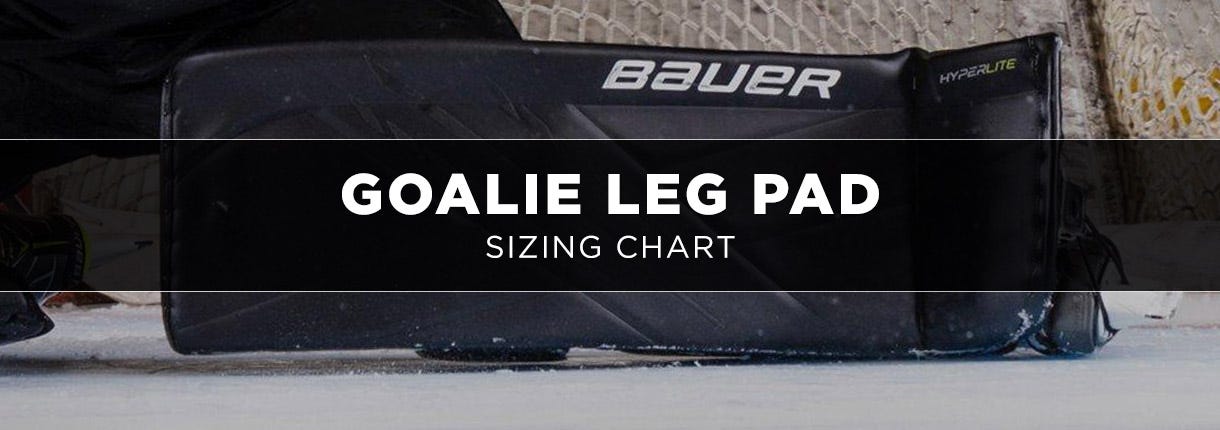
Finding the perfect size goalie pad can be key to being comfortable in net and playing your best. While the first instinct may be to pick a pad on the larger side, a pad too big for the goalie can significantly inhibit movement and be a detriment to their performance in net. Likewise, choosing a pad too small will provide better mobility, but could leave areas of the leg exposed and will reduce the amount of net the goalie covers. After first determining your playing style and the right type of pad (butterfly or hybrid) in our Guide to Goalie Leg Pads, you’re ready to find the right size. Already know your size? Check out our full selection of goalie leg pads here.
In this article, we’ll cover:
General Goalie Leg Pad Sizing Chart (by Age)
| Size | Youth | Junior | Intermediate | Senior |
| 19 | 10.25" - 11.5" | --- | --- | --- |
| 20 | 10.75" - 12" | --- | --- | --- |
| 21 | 11.25" - 12.5" | --- | --- | --- |
| 22 | 11.75" - 13" | --- | --- | --- |
| 23 | 12.25" - 13.5" | --- | --- | --- |
| 24 | --- | 13" - 14.5" | --- | --- |
| 26 | --- | 13.75" - 15.25" | --- | --- |
| 27 | --- | 14.5" - 15.5" | --- | --- |
| 28 | --- | 14.5" - 16" | --- | --- |
| 29 | --- | 15.25" - 16" | 15" - 16.5" | --- |
| 30 | --- | 15.5" - 16.5" | 15" - 17" | --- |
| 31 | --- | --- | 15.75" - 17" | --- |
| 32 | --- | --- | 16" - 18" | 16.5" - 18" |
| 33 | --- | --- | --- | 16.75" - 18.5" |
| 34 | --- | --- | --- | 17.5" - 19" |
| 35 | --- | --- | --- | 18" - 19.5" |
| 36 | --- | --- | --- | 18.5" - 20" |
*Disclaimer: Please see brand specific charts to see what’s best for you.
Goalie Leg Pad Sizing Charts by Brand
Bauer Goalie Leg Pad Sizing Chart
Bauer is the only company that measure their pads with a word such as "Large" instead of numbers. Please see the sizing chart with sizing equivalents to find the size you will need.
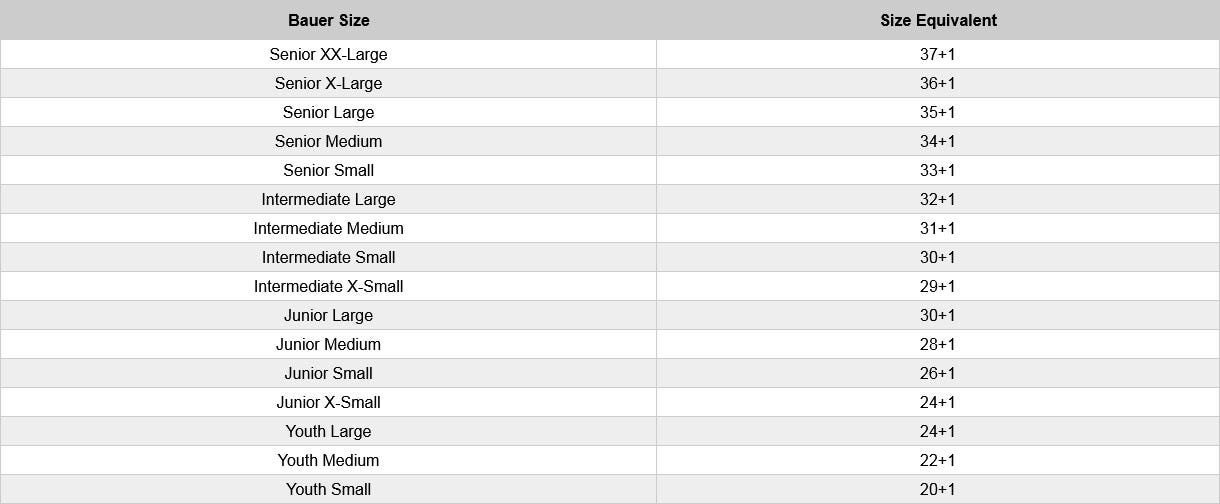
CCM Goalie Leg Pad Sizing Chart
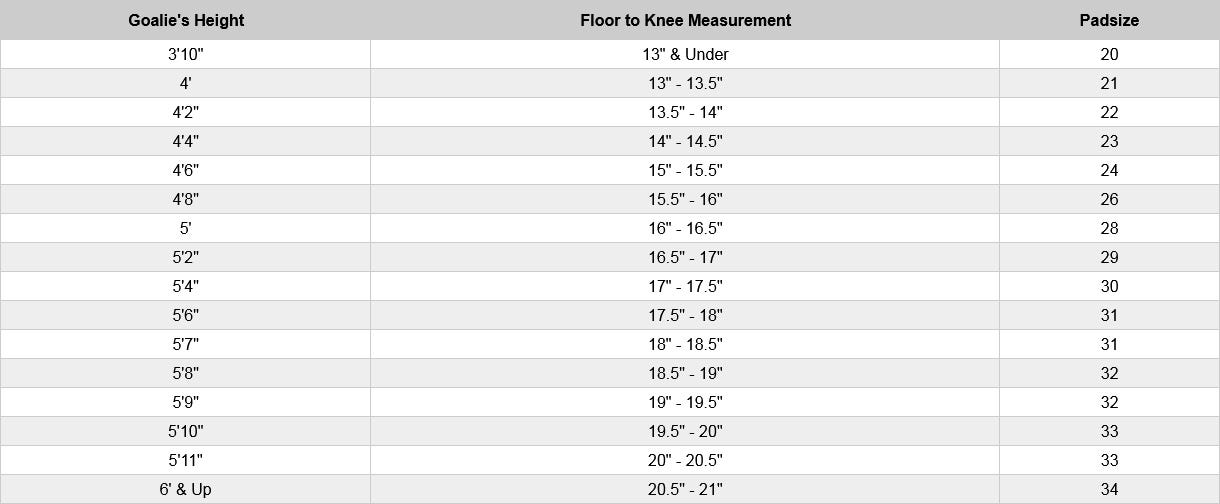
Warrior Goalie Leg Pad Sizing Chart
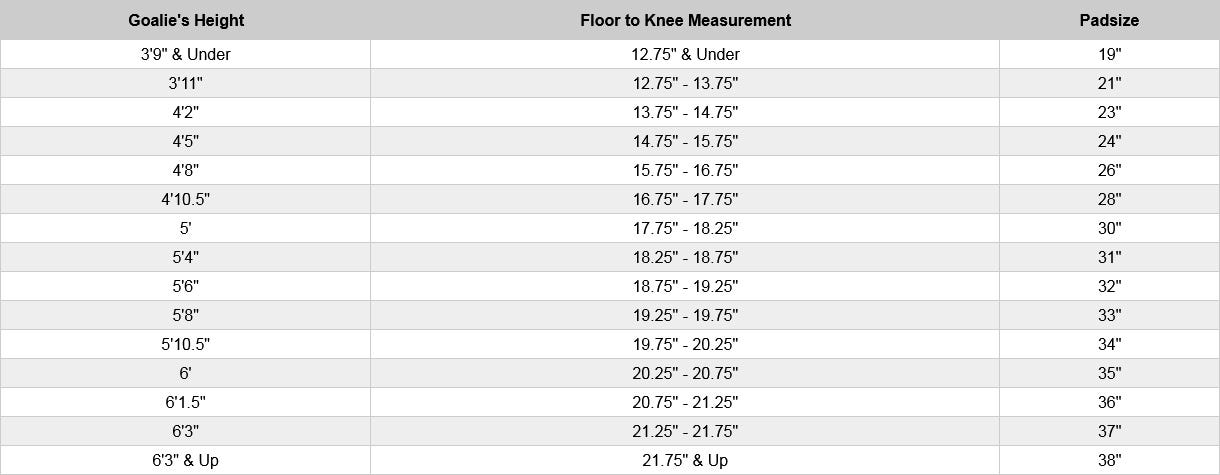
Brians Goalie Leg Pad Sizing Chart
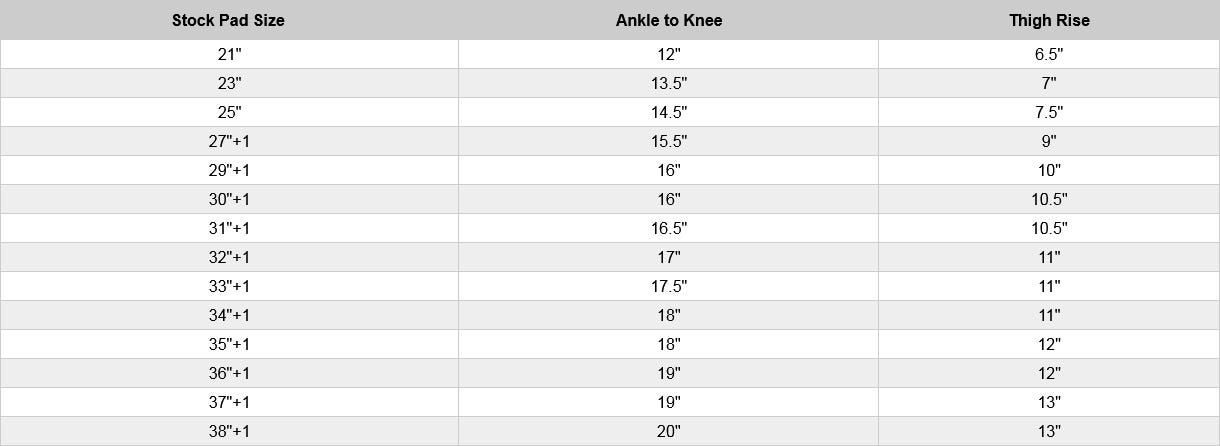
True Goalie Leg Pad Sizing Chart
True L12.2 Leg Pad

True L20.1 Leg Pad

How to Choose Goalie Leg Pads
To use the charts above, first, you will need to find your Ankle to Knee (ATK) measurement as outlined below. Ankle to Knee measurement is the best way to find the base size of the pad and is generally considered the industry standard when sizing goalie pads. The ultimate goal here is to have the knee land in the center of the knee stack when in the butterfly position. From there if you prefer a taller pad, use additional thigh rise to help cover the 5 hole when in butterfly. Be careful, more thigh rise is not always a benefit as it can cause the pad to be too tall and diminish your ability to be mobile. +1 thigh rise is typical and it is uncommon to see a goalie wear any more than +2 thigh rise. When trying on a pad to verify sizing, it is always recommended to try on the pad with the gear that interacts with the pad; skates, pants/breezers, and even socks/under garments.
We would also like to briefly cover the dilemma of choosing the right side pad for a growing young goalie. While instinct may be to choose a size of pad that will give them ample room to grow into, in reality too big of a pad can inhibit their skill development and create bad habits. It is critical that when sizing a pad for a growing goalie that when in the butterfly position, the knee lands on the knee stack. The goal here will be to have the knee land in the lower half (without sliding off), this way the goalie still has room to grow. Once the goalie’s knee reaches the top of the knee stack (when in butterfly position), it will be time to move on to the next size pad.
Determine Your ATK (Ankle to Knee) Measurement
Ankle to Knee (abbreviated ATK) is the most common measurement in finding the correct pad size. It is simply a measurement from the center of the ankle bone to the middle of the knee cap. This can be done using a soft tape measure or by measuring first with a piece of string and then measuring the length of the string.
Determine Your Thigh Rise Measurement
Thigh rise is the added height (measured in inches) at the top of a goalie pad. Thigh rise allows a goalie to wear the correct size pad (using ATK measurement) while adding height to the top of the pad to help cover more net and retain better coverage of the 5-hole when in the butterfly position. Thigh rise is identified with a “+” followed by a number (in inches). For example, a 33+2” goalie pad would have a base height of 33” and an additional 2 inches added to the top of the pad. Dimensionally, a 33+2” pad and a 34+1” pad will be the same overall height (top to bottom), however the 33+2” pad will have its knee stack lower than the 34+1” pad. A goalie should choose his/her base pad height based on their ATK measurement and then determine if additional thigh rise height is necessary based on their skill and playing style.
Choose Your Age Group
With your ideal pad size in hand, it's now time to choose the appropriate range of goalie pad. Most adult goalies will fall in the Senior size range and typically when a goalie reaches high-school age, they are using Senior sized pads.
When sizing for youth and younger goalies, this can get a little confusing as brands often overlap with sizes. For instance, Brand A may establish a 32” pad as an Intermediate, while Brand B calls it a Senior size. While the overall height between a 32” Intermediate and a 32” Senior pad will be the same, the important thing to note is often the widths will be slightly different. Most brands use a 10.5” or 10.75” core to Intermediate pads while Senior pads use an 11” core. The reduced width can be to the benefit of a smaller goalie as it helps them be more mobile and refine their skills before moving to a full senior pad while a smaller adult goalie would benefit from the added coverage of a 11” width pad.
Some differences should be noted in Junior and Youth pads as well. Youth pads generally feature a very basic design construction to help facilitate ease of learning the position and getting dressed before the game. Moving into Junior pads, this classification will benefit from additional protection and padding areas to help protect against shots as opponents become more skilled. Intermediate pads take the design factor a step further even.
With the information and measurements in hand to make a selection, head over to your classification of pad below to get started in finding the perfect pad!
You can also check out our complete guide on to how to choose hockey goalie leg pads.
Goalie Leg Pad FAQs
What does the +1 mean on goalie pads?
+1 (or “+” followed by a number) is the thigh rise of a pad, measured in inches. Thigh rise is built-in additional height at the top of the goalie pad. In short, it allows a goalie to wear a taller pad while still having the pad fit correctly at the knee and boot.
Where should goalie pads come up to?
The basis for sizing goalie pads is to have the top of the pad come to the middle of the thigh when standing straight up. Based on age and skill this may vary slightly, but the middle of the thigh is a good baseline when sizing goalie pads.
When did goalie pads get bigger?
Goalie pads have been evolving through the entire history of the game. In the age of modern goalie pads (typically defined as solid foam construction, rather than stuffed foam or deer hair) pads were first slimmed down in 2005 by new NHL regulations from 12” width to the current standard of 11” width. As goalies refined the butterfly style, they came to prefer a taller pad that covers more net and better coverage of 5-hole shots. In doing so, thigh rise was developed and goalies were able to comfortably play with taller pads that fit properly.
Find the Best Selection of Hockey Goalie Leg Pads at GoalieMonkey!
Whether you are a first time goalie or refreshing your gear for the new season, GoalieMonkey experts can help you find the right gear the first time. Our team of goalies have the answers to your questions because we play the position and live the game. After determining the right size of your new pads, check out our full selection of goalie leg pads.



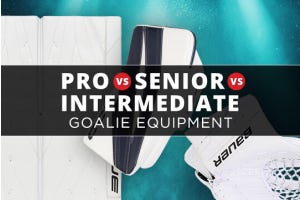

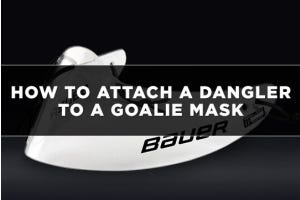



Login and Registration Form
or
Create an account